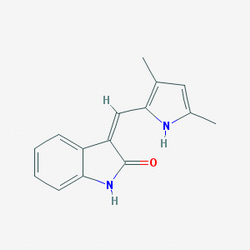Semaxanib (SU5416)
Cat. No.: DC7290
Featured
Chemical Structure
204005-46-9
We are official vendor of:
More than 5000 active chemicals with high quality for research!
Field of application
Semaxanib (SU5416) is a potent and selective VEGFR(Flk-1/KDR) inhibitor with IC50 of 1.23 μM, 20-fold more selective for VEGFR than PDGFRβ, lack of activity against EGFR, InsR and FGFR.
| Cas No.: |
204005-46-9 |
| Chemical Name: |
Semaxanib |
| Synonyms: |
Semaxinib; SU-5416; SU 5416 |
| SMILES: |
CC1=CC(=C(N1)/C=C\2/C3=CC=CC=C3NC2=O)C |
| Formula: |
C15H14N2O |
| M.Wt: |
238.28 |
| Sotrage: |
2 years -20°C Powder, 2 weeks 4°C in DMSO, 6 months -80°C in DMSO |
| Description: |
Semaxinib (SU5416) is a potent and selective inhibitor of the vascular endothelial growth factor receptor (Flk-1/KDR) with an IC50 of 1.23 μM. |
| In Vivo: |
Daily administration of Semaxinib (SU5416) (i.p., 3 mg/kg/day) inhibits the local growth of C6 tumors in the colon. A comparable level of growth inhibition (62% by day 16; P=0.001) is observed for tumors growing in the colon in comparison with ones growing in the hindflank region (54% by day 18; P=0.001). These results indicate that Semaxinib (SU5416) could inhibit tumor growth at a site other than the subcutaneous implantation site, where the preexisting vasculature may be different[1]. Daily treatment with Semaxinib (SU5416) (25 mg/kg) results in a significantly lower tumor growth rate with tumor masses of up to 8% of that present in control animals by day 22 after implantation. Inhibition of tumor growth is clearly preceded by a marked reduction of the tissue area covered by the newly formed glioma microvasculature in the Semaxinib-treated group, indicating a reduced initial tumor vascularization[2]. |
| In Vitro: |
Semaxinib (SU5416) inhibits VEGF-driven mitogenesis in a dose-dependent manner with an IC50 of 0.04±0.02 μM (n=3). In contrast, Semaxinib (SU5416) blocked FGF-dependent mitogenesis of HUVECs with an IC50 of 50 μM (n=10). The selective activity of Semaxinib (SU5416) on Flk-1 is supported by the fact that testing of Semaxinib (SU5416) using NIH 3T3 cells overexpressing either the EGF or insulin receptors indicated a complete lack of activity (IC50>100 μM). This observation is confirmed by immunoblotting after ligand stimulation. An IC50 of 20.26±5.2 μM (n=7), which is about 20-fold less in potency on PDGF-dependent autophosphorylation, is observed when SU5416 is tested in NIH 3T3 cells overexpressing the human PDGF receptor β[1]. |
MSDS
COA
| LOT NO. |
DOWNLOAD |
|

|
| 2018-0101 |

|
| 2018-0101 |

|
Get Quote






















